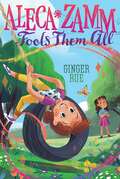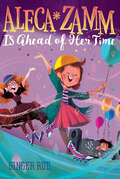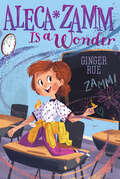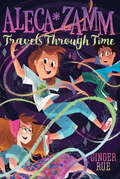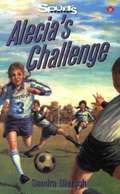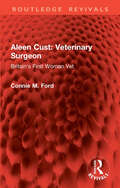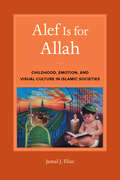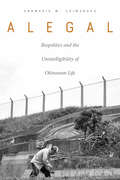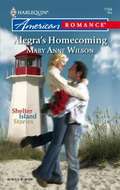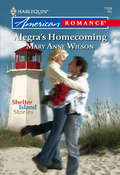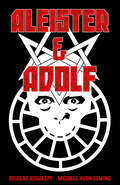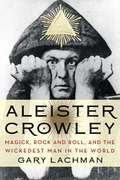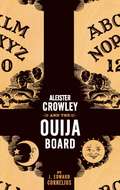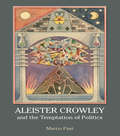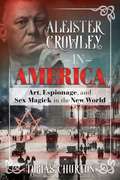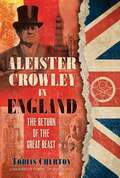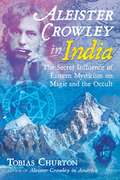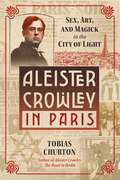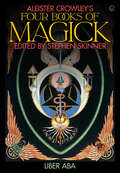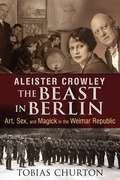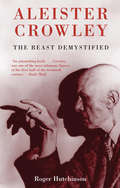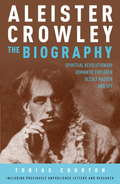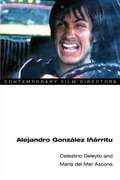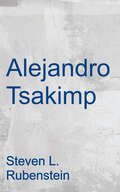- Table View
- List View
Aleca Zamm Fools Them All: Aleca Zamm Is A Wonder; Aleca Zamm Is Ahead Of Her Time; Aleca Zamm Fools Them All; Aleca Zamm Travels Through Time (Aleca Zamm #3)
by Ginger RueAleca Zamm, an ordinary ten-year-old with an extraordinary talent, finds a new friend and has to rescue her Aunt Zephyr from a teleportation crisis in this hilarious third novel in the Aleca Zamm chapter book series.Aleca Zamm knows she&’s not the only Wonder at school with a magical ability. Third grader Ford Kimble is a Wonder as well. Ford is able to see people as they used to be in the past and as they will be in the future. He can time travel! Well, sort of! Aleca starts hanging out with Ford to discuss their magical abilities, which makes Aleca&’s best friend, Maria, jealous. Aleca even forgot the first meeting of the Secret Pals Club, Maria and Aleca&’s new idea for a club that performs secret good deeds for bullied kids! Worse, Maria is onto Aleca&’s secret of being a Wonder. She definitely suspects something, but Aleca has sworn to Aunt Zephyr that she won&’t tell anyone about her magical ability. Plus, Aunt Zephyr&’s ability to teleport is starting to deteriorate along with her age, and Aunt Zephyr&’s about to throw in the towel on being a Wonder for good. Can Aleca and Ford figure out how to get Aunt Zephyr&’s magical powers back? And can Aleca save her friendship with Maria while still keeping her magical powers a secret?
Aleca Zamm Is Ahead of Her Time
by Ginger Rue Zoe PersicoAleca Zamm, an ordinary ten-year-old with an extraordinary talent, is on a mission to find the other Wonder at her school and find out what their special power is in this hilarious follow-up to Aleca Zamm Is a Wonder.Every roller-skating party has its pooper… And for Aleca Zamm, that pooper is Madison, her former best friend and current worst enemy. But Aleca’s mom insisted that Aleca invite her entire class to her tenth birthday party at the skating rink—including queen-of-mean Madison! What’s even worse? Aleca suspects that Madison knows about Aleca’s magical ability to freeze time. And that could mean over-the-top trouble for Aleca and Aunt Zephyr, her kooky teleporting aunt. There’s no telling what dangers await if news about their mysterious abilities gets out. Between Aunt Zephyr’s risky roller-skating tricks and Madison’s threat of spilling Aleca’s secret, Aleca is sure that her tenth birthday party will be a total disaster!
Aleca Zamm Is a Wonder
by Ginger Rue Zoe PersicoMeet the wonder-full Aleca Zamm, an ordinary ten-year-old with an extraordinary ability: she can stop time!Aleca Zamm has finally reached double digits and she still doesn’t have a “thing”—a special talent or ability that will make her stand out. Her best friend, Maria, has a thing (swim team); her sister, Dylan, has a thing (singing); and even her former BFF Madison has a thing (soccer). But Aleca? No. Thing. Until the day of her tenth birthday when Aleca discovers she can stop time just by saying her name. Suddenly, Aleca has a thing…and life is about to get a lot more interesting! It turns out that being a Wonder (as her eccentric Aunt Zephyr, who is also a Wonder, calls it) comes with a few caveats, and that stopping time doesn’t go undetected by other Wonders or those who may be searching for them. With her new mentor Aunt Zephyr by her side, Aleca discovers that being special comes with special challenges she never expected.
Aleca Zamm Travels Through Time: Aleca Zamm Is A Wonder; Aleca Zamm Is Ahead Of Her Time; Aleca Zamm Fools Them All; Aleca Zamm Travels Through Time (Aleca Zamm #4)
by Ginger RueAleca Zamm, an ordinary ten-year-old with an extraordinary talent, spends a day in the 1950s with Aunt Zephyr and Ford in this hilarious fourth novel in the Aleca Zamm chapter book series.For Aleca Zamm, being friends with Ford, a fellow Wonder, means even more magical adventures! Ford can see things from the past and future, and when he sees a bridge that no longer exists in the present, Aleca can’t wait to investigate. Hand in hand with Aunt Zephyr, the three of them manage to cross the bridge and climb through a portal into the past. Aleca, Ford, and Aunt Zephyr spend a day in the 1950s. At first, it’s exciting to see how things have changed, but time travel doesn’t come without snags! And when it’s time to go back home, they return to the bridge and find that the portal is gone! Will they be able to find a way home? Or are they stuck in the past for good?
Alecia's Challenge
by Sandra DierschAlecia's soccer team, the Vancouver Burrards, is the one stable thing in her life. Everything else is new or changing: a new school, a new stepfather. When Anne, Alecia's friend and the Burrards' best player, decides to quit playing, Alecia decides to fight to keep the team together. She soon learns, however, that life's hardest matches are fought off the soccer pitch. Alecia's Challenge shows how the struggles and joys of life and sport are intertwined.
Aleek Manush (Mythical Man)
by Sayad Mustafa Siraj Sudeshna ChakravartyThe novel presents an arresting picture of the turmoil going on in Bengali Muslim Society at the end of the nineteenth century. This includes a stricter, more puritanical way of life, abolition of 'pirs' or holy men and so on.
Aleen Cust Veterinary Surgeon: Britain's First Woman Vet (Routledge Revivals)
by Connie M. FordOriginally published in 1990, this book is a valuable contribution to the history of the veterinary profession in Great Britain and Ireland. Connie Ford’s book is a reminder of the great social changes that have taken place since Aleen Cust was born in 1868. When Aleen Cust entered the New Veterinary College, Edinburgh in 1895, and was later refused permission to sit the examinations of the Royal College of Veterinary Surgeons, no British woman had the vote. To the women students, only admitted to the London Veterinary College in 1927, she was a legend and an example. Now, a new generation of veterinarians, will find this account of the life and times of a truly remarkable woman a revelation.
Alef Is for Allah: Childhood, Emotion, and Visual Culture in Islamic Societies
by Jamal J. EliasAlef Is for Allah is the first groundbreaking study of the emotional space occupied by children in modern Islamic societies. Focusing primarily on visual representations of children from modern Turkey, Iran, and Pakistan, the book examines these materials to investigate concepts such as innocence, cuteness, gender, virtue, and devotion, as well as community, nationhood, violence, and sacrifice. In addition to exploring a subject that has never been studied comparatively before, Alef Is for Allah extends the boundaries of scholarship on emotion, religion, and visual culture and provides unique insight into Islam as it is lived and experienced in the modern world.
Alegal: Biopolitics and the Unintelligibility of Okinawan Life
by Annmaria M. ShimabukuOkinawan life, at the crossroads of American militarism and Japanese capitalism, embodies a fundamental contradiction to the myth of the monoethnic state. Suspended in a state of exception, Okinawa has never been an official colony of the Japanese empire or the United States, nor has it ever been treated as an equal part of Japan. As a result, Okinawans live amid one of the densest concentrations of U.S. military bases in the world. By bringing Foucauldian biopolitics into conversation with Japanese Marxian theory, Alegal uncovers Japan’s determination to protect its middle class from the racialized sexual contact around its mainland bases by displacing them onto Okinawa, while simultaneously upholding Okinawa as a symbol of the infringement of Japanese sovereignty.This symbolism, however, has provoked ambivalence within Okinawa. In base towns that facilitated encounters between G.I.s and Okinawan women, the racial politics of the United States collided with the postcolonial politics of the Asia Pacific. Through close readings of poetry, reportage, film, and memoir on base-town life since 1945, Shimabuku traces a continuing failure to “become Japanese.” What she discerns instead is a complex politics surrounding sex work, tipping with volatility along the razor’s edge between insurgency and collaboration. At stake in sovereign powers’ attempt to secure Okinawa as a military fortress was the need to contain alegality itself—that is, a life force irreducible to the legal order. If biopolitics is the state’s attempt to monopolize life, then Alegal is a story about how borderland actors reclaimed its power for themselves.
Alegra's Homecoming
by Mary Anne WilsonThe glossy curtain of blond hair, the cashmere coat-- nobody would ever connect the fabulous Alegra Reynolds with "Al" Peterson, the grimy little poor girl who'd hated growing up on Shelter Island, in Puget Sound. There'd been nobody to share her unhappiness then and there was nobody to appreciate her success now. Or was there? The island Joe Lawrence remembered was the perfect place to raise his three-year-old son, which is why the award-winning newspaperman decided to leave the bright lights and bustle of New York behind. A bit of sleuthing revealed a lot about the new Alegra, but nothing about her troubled past. Would the glamorous jet-setter touch down long enough for them to build a life together, or would she do what she'd done before-- simply walk away?
Alegra's Homecoming
by Mary Anne WilsonThe Good Thing About Coming HomeThe glossy curtain of blond hair, the cashmere coat-nobody would ever connect the fabulous Alegra Reynolds with "Al" Peterson, the grimy little poor girl who'd hated growing up on Shelter Island, in Puget Sound. There'd been nobody to share her unhappiness then and there was nobody to appreciate her success now.Or was there?Is That You're Never AloneThe island Joe Lawrence remembered was the perfect place to raise his three-year-old son, which is why the award-winning newspaperman decided to leave the bright lights and bustle of New York behind. A bit of sleuthing revealed a lot about the new Alegra, but nothing about her troubled past. Would the glamorous jet-setter touch down long enough for them to build a life together, or would she do what she'd done before-simply walk away?
Aleister & Adolf
by Douglas RushkoffMedia theorist and documentarian Douglas Rushkoff weaves a mind-bending tale of iconography and mysticism against the backdrop of a battle-torn Europe. In a story spanning generations, and featuring some of the most notable and notorious idealists of the 20th century, legendary occultist Aleister Crowley develops a powerful and dangerous new weapon to defend the world against Adolf Hitler's own war machine spawning an unconventional new form of warfare that is fought not with steel, but with symbols and ideas. Unfortunately, these intangible arsenals are much more insidious and perhaps much more dangerous than their creators could have ever conceived."Rushkoff is a cultural treasure and an eccentric author of big, strange ideas, never less than fascinating and always entertaining." -Warren Ellis, author of Gun Machine, Red, Trees, and Transmetropolitan"Douglas has been one of my personal heroes, and I've been a most attentive reader of anything he cares to put between covers, knowing that his combination of a cold eye and a warm heart is guaranteed to astonish and embolden my own thinking about what's possible in the world--about what's possible to enact in the space between one human being and another. He occupies the ground of our most immediate perplexities, and his reports of what he finds are breaking news." -Jonathan Lethem, author of The Best American Comics and The Fortress of Solitude
Aleister Crowley
by Gary LachmanThis definitive work on the occult's "great beast" traces the arc of his controversial life and influence on rock-and-roll giants, from the Rolling Stones to Led Zeppelin to Black Sabbath. When Aleister Crowley died in 1947, he was not an obvious contender for the most enduring pop-culture figure of the next century. But twenty years later, Crowley's name and image were everywhere. The Beatles put him on the cover of Sgt. Pepper's Lonely Hearts Club Band. The Rolling Stones were briefly serious devotees. Today, his visage hangs in goth clubs, occult temples, and college dorm rooms, and his methods of ceremonial magick animate the passions of myriad occultists and spiritual seekers. Aleister Crowley is more than just a biography of this compelling, controversial, and divisive figure--it's also a portrait of his unparalleled influence on modern pop culture.
Aleister Crowley and the Ouija Board
by J. Edward CorneliusPart fascinating history and part practical manual, this engaging guide takes the position that the Ouija Board is indeed as powerful as its detractors claim, revealing the dark secrets and hidden truths of this curious, enduring "game."
Aleister Crowley and the Temptation of Politics
by Marco PasiAleister Crowley (1875-1947) is one of the most famous and significant authors in the history of western esotericism. Crowley has been long ignored by scholars of religion whilst the stories of magical and sexual practice which circulate about him continue to attract popular interest. "Aleister Crowley and the Temptation of Politics" looks at the man behind the myth - by setting him firmly within the politics of his time - and the development of his ideas through his extensive and extraordinarily varied writings. Crowley was a rationalist, sympathetic to the values of the Enlightenment, but also a romantic and a reactionary. His search for an alternative way to express his religious feelings led him to elaborate his own vision of social and political change. Crowley's complex politics led to his involvement with many key individuals, organisations and groups of his day - the secret service of various countries, the German Nazi party, Russian political activists, journalists and politicians of various persuasions, as well as other writers - both in Europe and America. "Aleister Crowley and the Temptation of Politics" presents a life of ideas, an examination of a man shaped by and shaping the politics of his times.
Aleister Crowley in America: Art, Espionage, and Sex Magick in the New World
by Tobias ChurtonAn exploration of Crowley’s relationship with the United States • Details Crowley’s travels, passions, literary and artistic endeavors, sex magick, and psychedelic experimentation • Investigates Crowley’s undercover intelligence adventures that actively promoted U.S. involvement in WWI • Includes an abundance of previously unpublished letters and diaries Occultist, magician, poet, painter, and writer Aleister Crowley’s three sojourns in America sealed both his notoriety and his lasting influence. Using previously unpublished diaries and letters, Tobias Churton traces Crowley’s extensive travels through America and his quest to implant a new magical and spiritual consciousness in the United States, while working to undermine Germany’s propaganda campaign to keep the United States out of World War I. Masterfully recreating turn-of-the-century America in all its startling strangeness, Churton explains how Crowley arrived in New York amid dramatic circumstances in 1900. After other travels, in 1914 Crowley returned to the U.S. and stayed for five years: turbulent years that changed him, the world, and the face of occultism forever. Diving deeply into Crowley’s 5-year stay, we meet artists, writers, spies, and government agents as we uncover Crowley’s complex work for British and U.S. intelligence agencies. Exploring Crowley’s involvement with the birth of the Greenwich Village radical art scene, we discover his relations with writers Sinclair Lewis and Theodore Dreiser and artists John Butler Yeats, Leon Engers Kennedy, and Robert Winthrop Chanler while living and lecturing on now-vanished “Genius Row.” We experience his love affairs and share Crowley’s hard times in New Orleans and his return to health, magical dynamism, and the most colorful sex life in America. We examine his controversial political stunts, his role in the sinking of the passenger ship Lusitania, his making of the “Elixir of Life” in 1915, his psychedelic experimentation, his prolific literary achievements, and his run-in with Detroit Freemasonry. We also witness Crowley’s influence on Scientology founder L. Ron Hubbard and rocket fuel genius Jack Parsons. We learn why J. Edgar Hoover wouldn’t let Crowley back in the country and why the FBI raided Crowley’s organization in LA. Offering a 20th-century history of the occult movement in the United States, Churton shows how Crowley’s U.S. visits laid the groundwork for the establishment of his syncretic “religion” of Thelema and the now flourishing OTO, as well as how Crowley’s final wish was to have his ashes scattered in the Hamptons.
Aleister Crowley in England: The Return of the Great Beast
by Tobias Churton• Reveals Crowley&’s sex magick relations in London and his contacts with important figures, including Dion Fortune, Gerald Gardner, Jack Parsons, Dylan Thomas, and black equality activist Nancy Cunard • Explores Crowley&’s nick-of-time escape from the Nazi takeover in Germany and offers extensive confirmation of Crowley&’s work for British intelligence • Examines the development of Crowley&’s later publications and his articles in reaction to the Nazi Gestapo actively persecuting his followers in Germany After an extraordinary life of magical workings, occult fame, and artistic pursuits around the globe, Aleister Crowley was forced to spend the last fifteen years of his life in his native England, nearly penniless. Much less examined than his early years, this final period of the Beast&’s life was just as filled with sex magick, espionage, romance, transatlantic conflict, and extreme behavior. Drawing on previously unpublished diaries and letters, Tobias Churton provides the first detailed treatment of the final years of Crowley&’s life, from 1932 to 1947. He opens with Crowley&’s nick-of-time escape from the Nazi takeover in Germany and his return home to England, flat broke. Churton offers extensive confirmation of Crowley&’s work as a secret operative for MI5 and explores how Crowley saw World War II as the turning point for the &“New Aeon.&” He examines Crowley&’s notorious 1934 London trial, which resulted in his bankruptcy, and shares inside stories of Crowley&’s relations with Californian O.T.O. followers, including rocket-fuel specialist Jack Parsons, and his attempt to take over H. Spencer Lewis&’s Rosicrucian Order. The author reveals Crowley&’s sex magick relations in London and his contacts with spiritual leaders of the time, including Dion Fortune and Wicca founder Gerald Gardner. He examines Crowley&’s dealings with artists such as Dylan Thomas, Alfred Hitchcock, Augustus John, Peter Warlock, and Peter Brooks and dispels the accusations that Crowley was racist, exploring his work with lifelong friend, black equality activist Nancy Cunard. Churton also examines the development of Crowley&’s later publications such as Magick without Tears as well as his articles in reaction to the Nazi Gestapo who was actively persecuting his remaining followers in Germany. Presenting an intimate and compelling study of Crowley in middle and old age, Churton shows how the Beast still wields a wand-like power to delight and astonish.
Aleister Crowley in India: The Secret Influence of Eastern Mysticism on Magic and the Occult
by Tobias ChurtonFollow Aleister Crowley through his mystical travels in India, which profoundly influenced his magical system as well as the larger occult world • Shares excerpts from Crowley&’s unpublished diaries and details his travels in India, Burma, and Sri Lanka from 1901 to 1906 • Reveals how Crowley incorporated what he learned in India--jnana yoga, Vedantist, Tantric, and Buddhist philosophy--into his own school of Magick • Explores the world of Theosophy, yogis, Hindu traditions, and the first Buddhist sangha to the West as well as the first pioneering expeditions to K2 and Kangchenjunga in 1901 and 1905 Early in life, Aleister Crowley&’s dissociation from fundamentalist Christianity led him toward esoteric and magical spirituality. In 1901, he made the first of three voyages to the Indian subcontinent, searching for deeper knowledge and experience. His religious and magical system, Thelema, shows clear influence of his thorough experimental absorption in Indian mystical practices. Sharing excerpts from Crowley&’s unpublished diaries, Tobias Churton tells the true story of Crowley&’s adventures in India from 1901 to 1906, culminating in his first experience of the supreme trance of jnana (&“gnostic&”) yoga, Samadhi: divine union. Churton shows how Vedantist and Advaitist philosophies, Hindu religious practices, yoga, and Mahayana and Theravada Buddhism informed Crowley&’s spiritual system and reveals how he built on Madame Blavatsky and Henry Steel Olcott&’s prior work in India. Churton illuminates links between these beliefs and ancient Gnostic systems and shows how they informed the O.T.O. system through Franz Hartmann and Theodor Reuss. Churton explores Crowley&’s early breakthrough in consciousness research with a Dhyana trance in Sri Lanka, becoming a devotee of Shiva and Bhavani, fierce avatar of the goddess Parvati. Recounting Crowley&’s travels to the temples of Madurai, Anuradhapura, and Benares, Churton looks at the gurus of yoga and astrology Crowley met, while revealing his adventures with British architect, Edward Thornton. Churton also details Crowley&’s mountaineering feats in India, including the record-breaking attempt on Chogo Ri (K2) in 1902 and the Kangchenjunga disaster of 1905. Revealing how Crowley incorporated what he learned in India into his own school of Magick, including an extensive look at his theory of correspondences, the symbology of 777, and the Thelemic synthesis, Churton sheds light on one of the most profoundly mystical periods in Crowley&’s life as well as how it influenced the larger occult world.
Aleister Crowley in Paris: Sex, Art, and Magick in the City of Light
by Tobias Churton• Investigates the tales of Crowley &“raising Pan,&” going mad, and working gay sex magick in Paris• Uncovers Crowley&’s involvement in the Belle Époque with sculptor Auguste Rodin and other artists and in the 1920s with Berenice Abbott, Nancy Cunard, Man Ray, André Gide, and Aimée Crocker• Reveals Crowley&’s &“expulsion&” from Paris in 1929 as a high-level conspiracy against CrowleyExploring occultist, magician, poet, painter, and writer Aleister Crowley&’s longstanding and intimate association with Paris, Tobias Churton provides the first detailed account of Crowley&’s activities in the City of Light.Using previously unpublished letters and diaries, Churton explores how Crowley was initiated into the Golden Dawn&’s Inner Order in Paris in 1900 and how, in 1902, he relocated to Montparnasse. Soon engaged to Anglo-Irish artist Eileen Gray, Crowley pontificates and parties with English, American, and French artists gathered around sculptor Auguste Rodin: all keen to exhibit at Paris&’s famed Salon d&’Automne. In 1904—still dressed as &“Prince Chioa Khan&” and recently returned from his Book of the Law experience in Cairo—Crowleydines with novelist Arnold Bennett at Paillard&’s. In 1908 Crowley is back in Paris to prove it&’s possible to attain Samadhi (or &“knowledge and conversation of the Holy Guardian Angel&”) while living a modern life in a busy metropolis. In 1913 he organizes a demonstration for artistic and sexual freedom at Oscar Wilde&’s tomb. Until war spoils all in 1914, Paris is Crowley&’s playground.The author details how, after returning from America in 1920, and though based at his &“Abbey of Thelema&” in Sicily, Crowley can&’t leave Paris alone. When Mussolini expels him from Italy, Paris becomes his home from 1924 until 1929. Churton reveals Crowley&’s part in the jazz-age explosion of modernism, as the lover of photographer Berenice Abbott and many others, and how he enjoyed camaraderie with Man Ray, Nancy Cunard, André Gide, and Aimée Crocker. The author explores Crowley&’s adventures in Tunisia, Algeria, the Riviera,his battle with heroin addiction, his relationship with daughter Astarte Lulu—raised at Cefalù—and finally, a high-level ministerial conspiracy to get him out of Paris.Reconstructing Crowley&’s heyday in the last decade and a half of France&’s Belle Époque and the &“roaring Twenties,&” this book illuminates Crowley&’s place within the artistic, literary, and spiritual ferment of the great City of Light.
Aleister Crowley's Four Books of Magick
by Stephen SkinnerThis is the masterpiece of occultist, magician and philosopher Aleister Crowley, introduced for the first time by one of the world's leading experts on Western esoteric traditions, Stephen Skinner."Do what thou wilt."Written in the early twentieth century, the four books contained within this collection make up one of the most complete and groundbreaking works on the practice of magick ever written. They are considered to be the masterpiece of occultist, magician and philosopher Aleister Crowley and the core texts for the religion of Thelema. Their influence on alternative western thought and philosophy cannot be exaggerated.Also known as Book Four, or Liber ABA, the four parts bring together many rituals, received texts, theorems and unequalled insights into the practice of magick, culminating in The Book of the Law, the central, sacred text dictated to Crowley by a preternatural entity. Anyone interested in yoga, ceremonial magic, esoteric thought, invocation, divination and beyond, or those looking to delve into the fascinating, playful and illuminating writings of a unique man, will find inspiration.For the first time, one of the world's leading experts on Western esoteric traditions and magic, Dr. Stephen Skinner, introduces the text, sharing his insights into Crowley's take on yoga, ceremonial magick and Thelema. His long involvement with magick, both as an academic and as a practitioner, enabled Dr. Skinner to highlight the differences between the psychological and the spirit-orientated approaches to magick, and to show how that dilemma shaped Crowley's practice and his founding of Thelema, enlightening the reader to many previously unknown connections.
Aleister Crowley: Art, Sex, and Magick in the Weimar Republic
by Tobias ChurtonA biographical history of Aleister Crowley’s activities in Berlin from 1930 to 1932 as Hitler was rising to power • Examines Crowley’s focus on his art, his work as a spy for British Intelligence, his colorful love life and sex magick exploits, and his contacts with magical orders • Explores Crowley’s relationships with Berlin’s artists, filmmakers, writers, and performers such as Christopher Isherwood, Jean Ross, and Aldous Huxley • Recounts the fates of Crowley’s friends and colleagues under the Nazis as well as what happened to Crowley’s lost art exhibition Gnostic poet, painter, writer, and magician Aleister Crowley arrived in Berlin on April 18, 1930. As prophet of his syncretic religion “Thelema,” he wanted to be among the leaders of art and thought, and Berlin, the liberated future-gazing metropolis, wanted him. There he would live, until his hurried departure on June 22, 1932, as Hitler was rapidly rising to power and the black curtain of intolerance came down upon the city. Known to his friends affectionately as “The Beast,” Crowley saw the closing lights of Berlin’s artistic renaissance of the Weimar period when Berlin played host to many of the world’s most outstanding artists, writers, filmmakers, performers, composers, architects, philosophers, and scientists, including Albert Einstein, Bertolt Brecht, Ethel Mannin, Otto Dix, Aldous Huxley, Jean Ross, Christopher Isherwood, and many other luminaries of a glittering world soon to be trampled into the mud by the global bloodbath of World War II. Drawing on previously unpublished letters and diary material by Crowley, Tobias Churton examines Crowley’s years in Berlin and his intense focus on his art, his work as a spy for British Intelligence, his colorful love life and sex magick exploits, and his contacts with German Theosophy, Freemasonry, and magical orders. He recounts the fates of Crowley’s colleagues under the Nazis as well as what happened to Crowley’s lost art exhibition--six crates of paintings left behind in Germany as the Gestapo was closing in. Revealing the real Crowley long hidden from the historical record, Churton presents “the Beast” anew in all his ambiguous and, for some, terrifying glory, at a blazing, seminal moment in the history of the world.
Aleister Crowley: The Beast Demystified
by Roger HutchinsonAleister Crowley (1875-1947) - mystic, writer, poet, astrologer, sexual revolutionary, painter, mountain climber and social critic - has a terrifying reputation. The contemporary press labelled him the 'wickedest man in the world', while he called himself the 'great beast'. Crowley dabbled in the occult, supported Germany in the First World War, was addicted to opiates, and many who associated with him died tragically in mysterious circumstances.Working from the starting point that behind the demonic reputation there stood a human being, and that beyond the self-proclaimed black magician there was a man hungry for publicity and fame, Roger Hutchinson lifts the smokescreen of mythology to reveal a truly astonishing figure.Why did this curious product of the Plymouth Brethren found the first 'hippy commune' in Sicily? What led this Cambridge graduate to be celebrated 20 years after his death on the cover of The Beatles' Sergeant Pepper's Lonely Hearts Club Band album? Why did Mussolini expel him from Italy? Why did a British magazine label him 'the man we'd like to hang'? Roger Hutchinson reveals the real Crowley: warts, wickedness, talent, courage, cowardice and all.
Aleister Crowley: The Biography
by Tobias ChurtonIn early 20th-century England, Aleister Crowley (1875-1947) was considered "the wickedest man in the world." Today he's seen as a prophet, a master of the occult, and a spiritual pioneer--and his reputation just keeps on growing. This new biography, written with the cooperation of leading Crowley scholars and including new revelations from Crowley's grandson, displays the full scope of the man's many achievements as poet, explorer, spiritualist, wartime spy, and a thinker as significant as Jung, Freud, or Einstein.
Alejandro González Iñárritu (Contemporary Film Directors)
by Celestino Deleyto Maria Del AzconaThis in-depth study of Mexican film director Alejandro González Iñárritu explores his role in moving Mexican filmmaking from a traditional nationalist agenda towards a more global focus. Working in the United States and in Mexico, Iñárritu crosses national borders while his movies break the barriers of distribution, production, narration, and style. His features also experiment with transnational identity as characters emigrate and settings change. In studying the international scope of Iñárritu's influential films Amores Perros, 21 Grams, and Babel, Celestino Deleyto and María del Mar Azcona trace common themes such as human suffering and redemption, chance, and accidental encounters. The authors also analyze the director's powerful visual style and his consistent use of multiple characters and a fragmented narrative structure. The book concludes with a new interview with Iñárritu that touches on the themes and subject matter of his chief works.
Alejandro Tsakimp: A Shuar Healer In The Margins Of History (Fourth World Rising Ser.)
by Steven L. RubensteinIn the heavily forested foothills of the Andes Mountains in Ecuador, a Shuar healer named Alejandro Tsakimp leads many lives. He is a peasant who sells cattle and lumber, a member of the Shuar Federation, a son and a brother, a husband and a father, a student and a worker, and, finally, a troubled shaman. Being a healer has long been both a burden and a resource, for the power to cure is also the power to kill, and shamans like Tsakimp are frequently in danger from accusations of witchcraft. But the situation of the Shuar today is especially perilous, and Tsakimp must constantly negotiate relations of power not only with rival shamans and his patients, but with the better-educated and richer officials of the Shuar Federation and his own siblings as well.
